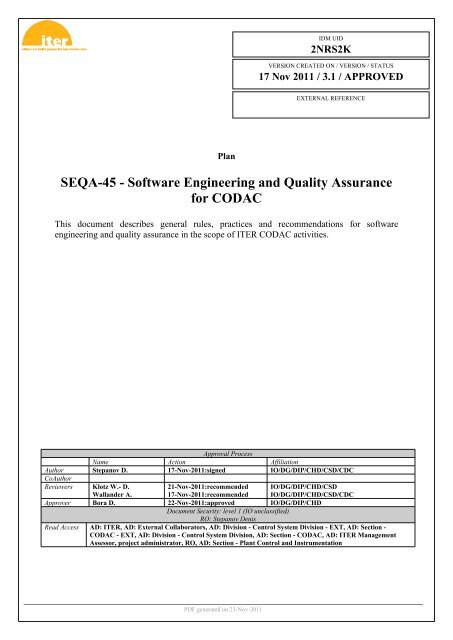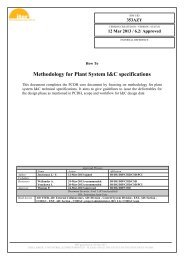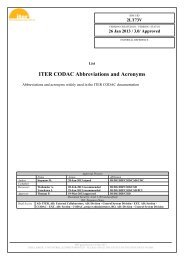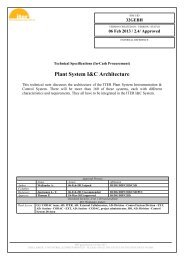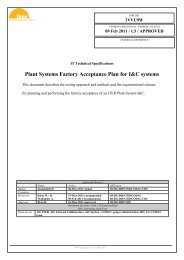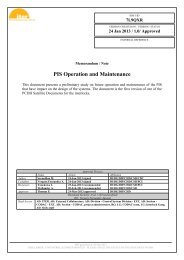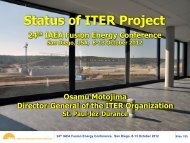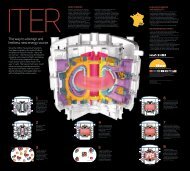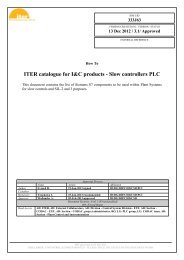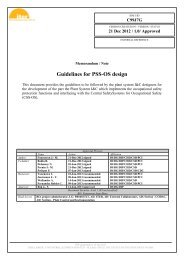SEQA-45 - Software Engineering and Quality Assurance for ... - Iter
SEQA-45 - Software Engineering and Quality Assurance for ... - Iter
SEQA-45 - Software Engineering and Quality Assurance for ... - Iter
You also want an ePaper? Increase the reach of your titles
YUMPU automatically turns print PDFs into web optimized ePapers that Google loves.
Change LogTitle (Uid) Version Latest Status Issue Date Description of Changev3.1 Approved 17 Nov2011<strong>SEQA</strong>-<strong>45</strong> - <strong>Software</strong><strong>Engineering</strong> <strong>and</strong> <strong>Quality</strong><strong>Assurance</strong> <strong>for</strong> CODAC(2NRS2K_v3_1)<strong>SEQA</strong>-<strong>45</strong> - <strong>Software</strong><strong>Engineering</strong> <strong>and</strong> <strong>Quality</strong><strong>Assurance</strong> <strong>for</strong> CODAC(2NRS2K_v3_0)<strong>SEQA</strong>-<strong>45</strong> - <strong>Software</strong><strong>Engineering</strong> <strong>and</strong> <strong>Quality</strong><strong>Assurance</strong> <strong>for</strong> CODAC(2NRS2K_v2_1)<strong>SEQA</strong>-<strong>45</strong> - <strong>Software</strong><strong>Engineering</strong> <strong>and</strong> <strong>Quality</strong><strong>Assurance</strong> <strong>for</strong> CODAC(2NRS2K_v2_0)<strong>SEQA</strong>-<strong>45</strong> - <strong>Software</strong><strong>Engineering</strong> <strong>and</strong> <strong>Quality</strong><strong>Assurance</strong> <strong>for</strong> CODAC(2NRS2K_v1_0)v3.0 In Work 20 Oct2011v2.1 Approved 11 Feb2011The version <strong>for</strong> the CODAC PDR:- Updated the documentation overview figure;- Implemented comments from J.Poole.Major rewrite in view of ISO/IEC 12207con<strong>for</strong>mance. Version <strong>for</strong> internal review.Minor corrections after the internal <strong>and</strong> externalreviews.v2.0 Signed 10 Jan 2011 Updated <strong>for</strong> the inclusion into the PCDH v6.v1.0 Approved 22 Jul 2009PDF generated on 23-Nov-2011
Table of contents1 INTRODUCTION...................................................................................................................31.1 Purpose ...............................................................................................................................31.2 PCDH Context ...................................................................................................................31.3 DDD-<strong>45</strong> Context.................................................................................................................41.4 Scope ...................................................................................................................................41.5 Definitions...........................................................................................................................41.6 References...........................................................................................................................62 CODAC ISO/IEC 12207 CONFORMITY............................................................................72.1 Approach ............................................................................................................................72.2 ISO/IEC 12207 Con<strong>for</strong>mity Statement............................................................................72.3 ISO/IEC 12207 Con<strong>for</strong>mity Matrix .................................................................................82.4 ISO/IEC 12207 Implementation Details ..........................................................................92.4.1 Acquisition Process......................................................................................................102.4.2 Supply Process .............................................................................................................102.4.3 Life Cycle Model Management Process ......................................................................102.4.4 Infrastructure Management Process.............................................................................102.4.5 Project Portfolio Management Process........................................................................112.4.6 Human Resource Management Process.......................................................................112.4.7 <strong>Quality</strong> Management Process ......................................................................................112.4.8 Project Planning Process..............................................................................................112.4.9 Project Assessment <strong>and</strong> Control Process .....................................................................122.4.10 Decision Management Process ....................................................................................122.4.11 Risk Management Process ...........................................................................................122.4.12 Configuration Management Process ............................................................................132.4.13 In<strong>for</strong>mation Management Process ...............................................................................132.4.14 Measurement Management Process.............................................................................132.4.15 Stakeholder Requirements Definition Process.............................................................132.4.16 System Requirements Analysis Process ......................................................................142.4.17 System Architectural Design Process ..........................................................................142.4.18 Implementation Process ...............................................................................................142.4.19 System Integration Process ..........................................................................................142.4.20 System Qualification Testing Process .........................................................................152.4.21 <strong>Software</strong> Installation Process.......................................................................................152.4.22 <strong>Software</strong> Acceptance Support Process.........................................................................152.4.23 <strong>Software</strong> Operation Process.........................................................................................152.4.24 <strong>Software</strong> Maintenance Process ....................................................................................162.4.25 <strong>Software</strong> Disposal Process...........................................................................................162.4.26 <strong>Software</strong> Implementation Process................................................................................162.4.27 <strong>Software</strong> Requirements Analysis Process....................................................................162.4.28 <strong>Software</strong> Architectural Design Process .......................................................................172.4.29 <strong>Software</strong> Detailed Design Process ...............................................................................172.4.30 <strong>Software</strong> Construction Process ....................................................................................172.4.31 <strong>Software</strong> Integration Process .......................................................................................172.4.32 <strong>Software</strong> Qualification Testing Process.......................................................................182.4.33 <strong>Software</strong> Documentation Management Process ..........................................................18Page 1 of 22
2.4.34 <strong>Software</strong> Configuration Management Process.............................................................182.4.35 <strong>Software</strong> <strong>Quality</strong> <strong>Assurance</strong> Process ...........................................................................182.4.36 <strong>Software</strong> Verification Process......................................................................................182.4.37 <strong>Software</strong> Validation Process ........................................................................................192.4.38 <strong>Software</strong> Review Process.............................................................................................192.4.39 <strong>Software</strong> Audit Process................................................................................................192.4.40 <strong>Software</strong> Problem Resolution Process .........................................................................192.4.41 Domain <strong>Engineering</strong> Process.......................................................................................192.4.42 Reuse Asset Management Process...............................................................................202.4.43 Reuse Program Management Process..........................................................................203 PRINCIPAL DOCUMENTATION.....................................................................................214 PROJECT CLASSIFICATION...........................................................................................22Page 2 of 22
1 INTRODUCTION1.1 PurposeThis document describes general rules, practices <strong>and</strong> recommendations <strong>for</strong> softwareengineering in the scope of ITER CODAC activities.1.2 PCDH ContextThe Plant Control Design H<strong>and</strong>book (PCDH) [RD1] defines the methodology, st<strong>and</strong>ards,specifications <strong>and</strong> interfaces applicable to ITER plant systems’ instrumentation <strong>and</strong> control(I&C) system life cycle. I&C st<strong>and</strong>ards are essential <strong>for</strong> ITER to:Integrate all plant systems into one integrated control system;Maintain all plant systems after delivery acceptance;Contain cost by economy of scale.The PCDH comprises a core document which presents the plant system I&C life cycle <strong>and</strong>recaps the main rules to be applied to the plant system I&Cs <strong>for</strong> conventional controls,interlocks <strong>and</strong> safety controls. Some I&C topics will be explained in greater detail in dedicateddocuments associated with PCDH as presented on Figure 1-1. This document is one of them.Its objective is to describe the software engineering <strong>and</strong> quality assurance (QA) in more detail.Figure 1-1: PCDH documentation structurePage 3 of 22
1.3 DDD-<strong>45</strong> ContextThe Design Description Document <strong>for</strong> CODAC (DDD-<strong>45</strong>, [RD2]) describes CODAC designassumptions <strong>and</strong> c<strong>and</strong>idate solutions <strong>for</strong> them. Some of these topics are covered in more detailin the annex documents. This document makes a part of the DDD-<strong>45</strong> package focusing on thesoftware engineering <strong>and</strong> QA topic.1.4 ScopeThis document describes general rules, practices <strong>and</strong> recommendations <strong>for</strong> softwareengineering in the scope of ITER CODAC activities. It defines the overall approach;technology-specific topics are described in separate reference documents.The content of this document applies to the development of the CODAC System (PBS <strong>45</strong>).Plant system I&Cs prepared in the scope of the PCDH are also subject to these requirements.The Central Interlock System (PBS 46), the plasma control algorithms (PBS 47), <strong>and</strong> CentralSafety Systems (PBS 48) are not addressed yet.This document is primarily focused on the CODAC System (PBS <strong>45</strong>). Chapter 2 gives ast<strong>and</strong>ard con<strong>for</strong>mity statement <strong>for</strong> CODAC.<strong>Software</strong> <strong>for</strong> control system elements qualified as COTS devices does not have to follow theserules <strong>and</strong> should follow the engineering <strong>and</strong> quality assurance guidelines of their respectivemanufacturers <strong>and</strong>/or maintainers instead. COTS components will be selected in such a waythat their integration does not degrade the overall quality level of CODAC.1.5 DefinitionsMany terms <strong>and</strong> definitions used in this document are explained in the glossary of the ISO/IEC12207 st<strong>and</strong>ard ([RD3]).The ISO/IEC 12207 st<strong>and</strong>ard is broken down into two main parts – system engineering <strong>and</strong>software engineering. By the “system” we underst<strong>and</strong> hereafter a plant system I&C or a centralsystem (central systems are treated as plant systems PBS <strong>45</strong>, PBS 46, PBS 47 <strong>and</strong> PBS 48, withsome special control features). The system includes both hardware <strong>and</strong> software. Systemengineering in the I&C context is addressed by the PCDH ([RD1]) <strong>and</strong> this annex document isfocused on software engineering. For some processes the system engineering <strong>for</strong> I&C followsthe same life cycle as <strong>for</strong> its plant system <strong>and</strong> is thus governed by overall ITER Organization(IO) practices; this is noted specifically in section 2.2.The following abbreviations <strong>and</strong> acronyms are used in this document (Table 1-1):ADMCIECISCODACCOTSCWSD-TDDDADMinistration directorateCentral Integration <strong>and</strong> <strong>Engineering</strong> directorateCentral Interlock SystemControl, Data Access <strong>and</strong> CommunicationCommercial Off-The-ShelfCooling Water SystemDeuterium-TritiumDesign Description DocumentPage 4 of 22
DOORSDRDTEPICSFDISFPGAGDHMIHPNI&CIDMIECIOISOLCCPBSPCDHPISPLCPSPSSQAR&DRDSADDSCCSCMPSCPSDMPSDPSDSD<strong>SEQA</strong>SPMPSQAPSQLSQSSRCSRDSRSSSPDynamic Object Oriented Requirements SystemDocument ReviewDocument TemplatesExperimental Physics <strong>and</strong> Industrial Control SystemFinal Draft International St<strong>and</strong>ardField Programmable Gate ArrayGeneric DocumentHuman-Machine InterfaceHigh Per<strong>for</strong>mance NetworksInstrumentation <strong>and</strong> ControlITER Document ManagementInternational Electrotechnical CommissionITER OrganizationInternational St<strong>and</strong>ards OrganizationLocal Control CubiclePlant Breakdown StructurePlant Control Design H<strong>and</strong>bookPlant Interlock SystemProgrammable Logic ControllerPlant SystemPlant Safety System<strong>Quality</strong> <strong>Assurance</strong>Research <strong>and</strong> DevelopmentReference Document<strong>Software</strong> Architecture <strong>and</strong> Design DescriptionSignal Conditioning Cubicle<strong>Software</strong> Configuration Management PlanSystem Context Processes<strong>Software</strong> Documentation Management Plan<strong>Software</strong> Development Plan<strong>Software</strong> Development St<strong>and</strong>ards Description<strong>Software</strong> <strong>Engineering</strong> <strong>and</strong> <strong>Quality</strong> <strong>Assurance</strong><strong>Software</strong> Project Management Plan<strong>Software</strong> <strong>Quality</strong> <strong>Assurance</strong> PlanStructured Query LanguageSafety, <strong>Quality</strong> <strong>and</strong> Security departmentSouRCe codeSystem Requirements Document<strong>Software</strong> Requirements Specification<strong>Software</strong> Specific ProcessesPage 5 of 22
STPSTRSUMSVNSWTBD<strong>Software</strong> Test Plan<strong>Software</strong> Test Report<strong>Software</strong> User ManualSubVersioNSoftWareTo Be Defined-T Template-β Beta- or draft versionTable 1-1: Abbreviations1.6 References[RD1][RD2][RD3][RD4][RD5][RD6][RD7][RD8][RD9][RD10][RD11][RD12][RD13][RD14][RD15][RD16][RD17][RD18][RD19][RD20][RD21][RD22][RD23][RD24][RD25]Plant Control Design H<strong>and</strong>book (27LH2V v6.1)CODAC DDD (6M58M9 v1.1)ISO/IEC FDIS 12207:2008(E) (http://www.iso.org/iso/catalogue_detail?csnumber=43447)Plant Systems Factory Acceptance Plan <strong>for</strong> I&C systems (3VVU9W v1.5)ITER Procurement <strong>Quality</strong> Requirements (22MFG4 v4.0)IDM Manual (22223J v5.12)Central I&C Systems - Implementation Plan (33HDSA v1.0)CODAC Inventory Management System (4EEDXH)Linux Admin Pages (https://portal.iter.org/departments/CHD/CODAC/Linux%20Admin/1ndex.aspx)SPMP-<strong>45</strong> – <strong>Software</strong> Project Management Plan <strong>for</strong> CODAC (6SGJKJ, version TBD)ITER <strong>Quality</strong> <strong>Assurance</strong> Program (22K4QX v7.3)ITER Templates (2DJT9B)System Requirements Documents (SRDs) (29D6G7)Using DOORS on ITER Technical Baseline Documents (2MR6Z9 v1.1)Design Review Procedure (2832CF v1.12)System Design Description Documents (DDDs) (29D8PA)CODAC Core System Installation Manual (33JNKW v1.17)CODAC Core System Training (4F9M4T)CODAC Core System Support Procedures (34EHTM v1.3)Core Systems Roadmap (2LTB5T v3.0)Bugzilla Tutorial (33KAC4 v1.0)SDP-<strong>45</strong> – <strong>Software</strong> Development Plan <strong>for</strong> CODAC (6SLYRM v1.0)SDMP-<strong>45</strong> – <strong>Software</strong> Documentation Management Plan <strong>for</strong> CODAC (6SR4UQ v1.0)SCMP-<strong>45</strong> – <strong>Software</strong> Configuration Management Plan <strong>for</strong> CODAC (6SNQCR v1.0)SQAP-<strong>45</strong> – <strong>Software</strong> <strong>Quality</strong> <strong>Assurance</strong> Plan <strong>for</strong> CODAC (6SNDEV v1.0)Page 6 of 22
2.1 Approach2 CODAC ISO/IEC 12207 CONFORMITYCODAC has decided to follow the ISO/IEC 12207 international st<strong>and</strong>ard ([RD3]) <strong>for</strong> itssoftware-related activities. This st<strong>and</strong>ard breaks down all the software activities into groups ofprocesses, which are presented in Figure 2-1.Figure 2-1: ISO/IEC 12207 life cycle processesHereafter, “the International St<strong>and</strong>ard” refers to the ISO/IEC 12207, as defined in the reference[RD3].2.2 ISO/IEC 12207 Con<strong>for</strong>mity StatementCODAC claims tailored con<strong>for</strong>mity <strong>for</strong> all processes defined in the ISO/IEC 12207International St<strong>and</strong>ard, except <strong>for</strong> the Project Portfolio Management Process.The tailored con<strong>for</strong>mity claim is based on the zero level analysis executed <strong>for</strong> existing practicesof CODAC <strong>and</strong> ITER Organization. The ultimate goal of st<strong>and</strong>ardization is to go <strong>for</strong> fullcon<strong>for</strong>mity <strong>for</strong> some of the a<strong>for</strong>ementioned processes, subject to thorough analysis,documentation <strong>and</strong> adjustment of the existing processes. This will be gradually implemented inthe future.Page 7 of 22
2.3 ISO/IEC 12207 Con<strong>for</strong>mity MatrixThe Table 2-1 summarizes the current con<strong>for</strong>mity level <strong>for</strong> CODAC. The cell color means thefollowing: green – the process has been implemented (levels 1 to 5 on the process capabilityscale, as defined in Annex B of the St<strong>and</strong>ard ([RD3])); yellow – the process has been partiallyimplemented (level 0 on the process capability scale); red – the process is missing / notimplemented; no color – the process is not applicable. The cell content means the following:“IO” – regular IO procedures apply; “IO + CODAC” – CODAC-specific procedures definedon top of the regular IO procedures; “CODAC” – the procedures defined only in the CODACcontext.№ Process CODAC implementation Details (see section)1 Acquisition Process IO + CODAC 2.4.12 Supply Process IO 2.4.23 Life Cycle Model Management Process CODAC 2.4.34 Infrastructure Management Process CODAC 2.4.<strong>45</strong> Project Portfolio Management Process N/A 2.4.56 Human Resource Management Process IO + CODAC 2.4.67 <strong>Quality</strong> Management Process IO 2.4.78 Project Planning Process IO + CODAC 2.4.89 Project Assessment <strong>and</strong> Control Process IO + CODAC 2.4.910 Decision Management Process IO 2.4.1011 Risk Management Process IO + CODAC 2.4.1112 Configuration Management Process IO 2.4.1213 In<strong>for</strong>mation Management Process IO 2.4.1314 Measurement Management Process IO 2.4.1415 Stakeholder Requirements Definition Process IO 2.4.1516 System Requirements Analysis Process IO 2.4.1617 System Architectural Design Process IO 2.4.1718 Implementation Process IO 2.4.1819 System Integration Process IO 2.4.1920 System Qualification Testing Process IO 2.4.20Page 8 of 22
21 <strong>Software</strong> Installation Process IO + CODAC 2.4.2122 <strong>Software</strong> Acceptance Support Process CODAC 2.4.2223 <strong>Software</strong> Operation Process IO + CODAC 2.4.2324 <strong>Software</strong> Maintenance Process CODAC 2.4.2425 <strong>Software</strong> Disposal Process CODAC 2.4.2526 <strong>Software</strong> Implementation Process CODAC 2.4.2627 <strong>Software</strong> Requirements Analysis Process CODAC 2.4.2728 <strong>Software</strong> Architectural Design Process CODAC 2.4.2829 <strong>Software</strong> Detailed Design Process CODAC 2.4.2930 <strong>Software</strong> Construction Process CODAC 2.4.3031 <strong>Software</strong> Integration Process CODAC 2.4.3132 <strong>Software</strong> Qualification Testing Process CODAC 2.4.3233 <strong>Software</strong> Documentation Management Process CODAC 2.4.3334 <strong>Software</strong> Configuration Management Process CODAC 2.4.3435 <strong>Software</strong> <strong>Quality</strong> <strong>Assurance</strong> Process CODAC 2.4.3536 <strong>Software</strong> Verification Process CODAC 2.4.3637 <strong>Software</strong> Validation Process CODAC 2.4.3738 <strong>Software</strong> Review Process CODAC 2.4.3839 <strong>Software</strong> Audit Process CODAC 2.4.3940 <strong>Software</strong> Problem Resolution Process CODAC 2.4.4041 Domain <strong>Engineering</strong> Process CODAC 2.4.4142 Reuse Asset Management Process CODAC 2.4.4243 Reuse Program Management Process CODAC 2.4.43Table 2-1: ISO/IEC 12207 con<strong>for</strong>mity matrix <strong>for</strong> CODAC2.4 ISO/IEC 12207 Implementation DetailsCODAC implements the ISO/IEC 12207 processes to a different level of completeness <strong>and</strong>/orrobustness, depending on the current activities <strong>and</strong> priorities. The following sections provideexplanations of process implementation.Page 9 of 22
2.4.1 Acquisition ProcessPurpose:The purpose of the Acquisition Process is to obtain the product <strong>and</strong>/or service that satisfy theneed expressed by the acquirer. The process begins with the identification of customer needs<strong>and</strong> ends with the acceptance of the product <strong>and</strong>/or service needed by the acquirer.Implementation:St<strong>and</strong>ard IO practices apply (defined <strong>and</strong> maintained by the IO Department <strong>for</strong> Administration,Procurement <strong>and</strong> Contract Division). The acquirer acceptance activity in the scope of PCDH isdefined in reference [RD4].2.4.2 Supply ProcessPurpose:The purpose of the Supply Process is to provide a product or service to the acquirer that meetsthe agreed requirements.Implementation:St<strong>and</strong>ard IO practices apply (defined <strong>and</strong> maintained by the IO Department <strong>for</strong> Administration,Procurement <strong>and</strong> Contract Division). The quality requirements <strong>for</strong> procurement are defined inreference [RD5].2.4.3 Life Cycle Model Management ProcessPurpose:The purpose of the Life Cycle Model Management Process is to define, maintain, <strong>and</strong> assureavailability of policies, life cycle processes, life cycle models, <strong>and</strong> procedures <strong>for</strong> use by theorganization with respect to the scope of this International St<strong>and</strong>ard.This process provides life cycle policies, processes, <strong>and</strong> procedures that are consistent with theorganization's objectives, that are defined, adapted, improved <strong>and</strong> maintained to supportindividual project needs within the context of the organization, <strong>and</strong> that are capable of beingapplied using effective, proven methods <strong>and</strong> tools.Implementation:This process is implemented selectively <strong>for</strong> the most important life cycle models, like the I&Clife cycle, documented in the PCDH ([RD1]). The working instrument <strong>for</strong> this process is IDM(see [RD6]).2.4.4 Infrastructure Management ProcessPurpose:The purpose of the Infrastructure Management Process is to provide the enabling infrastructure<strong>and</strong> services to projects to support organization <strong>and</strong> project objectives throughout the life cycle.This process defines, provides <strong>and</strong> maintains the facilities, tools, <strong>and</strong> communications <strong>and</strong>in<strong>for</strong>mation technology assets needed <strong>for</strong> the organization’s business with respect to the scopeof this International St<strong>and</strong>ard.Page 10 of 22
Implementation:CODAC has defined a strategy <strong>for</strong> infrastructure procurement <strong>and</strong> management which isdescribed in references [RD7] <strong>and</strong> Error! Reference source not found.. The process issupported by the inventory database [RD8] <strong>and</strong> is documented in SharePoint [RD9].2.4.5 Project Portfolio Management ProcessPurpose:The purpose of the Project Portfolio Management Process is to initiate <strong>and</strong> sustain necessary,sufficient <strong>and</strong> suitable projects in order to meet the strategic objectives of the organization.This process commits the investment of adequate organization funding <strong>and</strong> resources, <strong>and</strong>sanctions the authorities needed to establish selected projects. It per<strong>for</strong>ms continuedqualification of projects to confirm they justify, or can be redirected to justify, continuedinvestment.Implementation:This process is not very applicable in the ITER context. Certain R&D projects could bemanaged under this process.2.4.6 Human Resource Management ProcessPurpose:The purpose of the Human Resource Management Process is to provide the organization withnecessary human resources <strong>and</strong> to maintain their competencies, consistent with business needs.The process assures the providing of a supply of skilled <strong>and</strong> experienced personnel qualified toper<strong>for</strong>m life cycle processes to achieve organization, project <strong>and</strong> customer objectives.Implementation:St<strong>and</strong>ard organization practices apply (defined <strong>and</strong> maintained by the IO Department <strong>for</strong>Administration, Human Resources Division). Projected profile of CODAC hiring until theITER D-T phase is available in reference [RD7]. <strong>Software</strong> management aspects are covered inthe CODAC software project management plan [RD10].2.4.7 <strong>Quality</strong> Management ProcessPurpose:The purpose of the <strong>Quality</strong> Management Process is to assure that products, services <strong>and</strong>implementations of life cycle processes meet organizational quality objectives <strong>and</strong> achievecustomer satisfaction.Implementation:St<strong>and</strong>ard IO practices apply (defined <strong>and</strong> maintained by the IO Department <strong>for</strong> Safety, <strong>Quality</strong><strong>and</strong> Security, <strong>Quality</strong> <strong>Assurance</strong> Division). The general process is described in [RD10].<strong>Software</strong>-specific procedures are covered in section 2.4.35.Page 11 of 22
2.4.8 Project Planning ProcessPurpose:The purpose of the Project Planning Process is to produce <strong>and</strong> communicate effective <strong>and</strong>workable project plans.This process determines the scope of the project management <strong>and</strong> technical activities, identifiesprocess outputs, project tasks <strong>and</strong> deliverables, establishes schedules <strong>for</strong> project task conduct,including achievement criteria, <strong>and</strong> required resources to accomplish project tasks.Implementation:St<strong>and</strong>ard IO practices apply (defined <strong>and</strong> maintained by the IO Department <strong>for</strong> Administration,Project Management Division). <strong>Software</strong> management aspects are covered in the CODACsoftware project management plan [RD10].2.4.9 Project Assessment <strong>and</strong> Control ProcessPurpose:The purpose of the Project Assessment <strong>and</strong> Control Process is to determine the status of theproject <strong>and</strong> ensure that the project per<strong>for</strong>ms according to plans <strong>and</strong> schedules, <strong>and</strong> withinprojected budgets, <strong>and</strong> that it satisfies technical objectives.This process includes redirecting the project activities, as appropriate, to correct identifieddeviations <strong>and</strong> variations from other project management or technical processes. Redirectionmay include replanning as appropriate.Implementation:St<strong>and</strong>ard IO practices apply (defined <strong>and</strong> maintained by the IO Department <strong>for</strong> Administration,Project Management Division). <strong>Software</strong> management aspects are covered in the CODACsoftware project management plan [RD10].2.4.10 Decision Management ProcessPurpose:The purpose of the Decision Management Process is to select the most beneficial course ofproject action where alternatives exist.This process responds to a request <strong>for</strong> a decision encountered during the system life cycle,whatever its nature or source, in order to reach specified, desirable or optimized outcomes.Alternative actions are analyzed <strong>and</strong> a course of action selected <strong>and</strong> directed. Decisions <strong>and</strong>their rationale are recorded to support future decision-making.Implementation:St<strong>and</strong>ard IO practices apply (defined <strong>and</strong> maintained by the IO Department <strong>for</strong> Administration,Project Management Division).2.4.11 Risk Management ProcessPurpose:The purpose of the Risk Management Process is to identify, analyze, treat <strong>and</strong> monitor the riskscontinuously.Page 12 of 22
The Risk Management Process is a continuous process <strong>for</strong> systematically addressing riskthroughout the life cycle of a system or software product or service. It can be applied to risksrelated to the acquisition, development, maintenance or operation of a system.Implementation:St<strong>and</strong>ard IO practices apply (defined <strong>and</strong> maintained by the IO Department <strong>for</strong> Administration,Project Management Division). <strong>Software</strong> management aspects are covered in the CODACsoftware project management plan [RD10].2.4.12 Configuration Management ProcessPurpose:The purpose of the Configuration Management Process is to establish <strong>and</strong> maintain theintegrity of all identified outputs of a project or process <strong>and</strong> make them available to concernedparties.Implementation:St<strong>and</strong>ard IO practices apply (defined <strong>and</strong> maintained by the IO Department <strong>for</strong> ITER Project,Technical Integration Division). <strong>Software</strong>-specific procedures are covered in section 2.4.34.2.4.13 In<strong>for</strong>mation Management ProcessPurpose:The purpose of the In<strong>for</strong>mation Management Process is to provide relevant, timely, complete,valid <strong>and</strong>, if required, confidential in<strong>for</strong>mation to designated parties during <strong>and</strong>, as appropriate,after the system life cycle.This process generates, collects, trans<strong>for</strong>ms, retains, retrieves, disseminates <strong>and</strong> disposes ofin<strong>for</strong>mation. It manages designated in<strong>for</strong>mation, including technical, project, organizational,agreement <strong>and</strong> user in<strong>for</strong>mation.Implementation:St<strong>and</strong>ard IO practices apply (defined <strong>and</strong> maintained by the IO Department <strong>for</strong> Administration,Document Control <strong>and</strong> Project In<strong>for</strong>mation System Sections). The principal instrument is IDM(see [RD6]). St<strong>and</strong>ard document templates are given in reference [RD12].2.4.14 Measurement Management ProcessPurpose:The purpose of the Measurement Process is to collect, analyze, <strong>and</strong> report data relating to theproducts developed <strong>and</strong> processes implemented within the organizational unit, to supporteffective management of the processes <strong>and</strong> to objectively demonstrate the quality of theproducts.Implementation:St<strong>and</strong>ard IO practices apply (defined <strong>and</strong> maintained by the IO Department <strong>for</strong> Administration,Project Management Division).Page 13 of 22
2.4.15 Stakeholder Requirements Definition ProcessPurpose:The purpose of the Stakeholder Requirements Definition Process is to define the requirements<strong>for</strong> a system that can provide the services needed by users <strong>and</strong> other stakeholders in a definedenvironment.It identifies stakeholders, or stakeholder classes, involved with the system throughout its lifecycle, <strong>and</strong> their needs <strong>and</strong> desires. It analyzes <strong>and</strong> trans<strong>for</strong>ms these into a common set ofstakeholder requirements that express the intended interaction the system will have with itsoperational environment <strong>and</strong> that are the reference against which each resulting operationalservice is validated in order to confirm that the system fulfils needs.Implementation:St<strong>and</strong>ard IO practices apply (defined <strong>and</strong> maintained by the IO Department <strong>for</strong> ITER Project,Technical Integration Division).2.4.16 System Requirements Analysis ProcessPurpose:The purpose of System Requirements Analysis is to trans<strong>for</strong>m the defined stakeholderrequirements into a set of desired system technical requirements that will guide the design ofthe system.Implementation:St<strong>and</strong>ard IO practices apply (defined <strong>and</strong> maintained by the IO Department <strong>for</strong> ITER Project,Technical Integration Division). System requirements are maintained as set of changecontrolled documents, available in reference [RD13]. The tool to manage requirements isDOORS (see [RD14]).2.4.17 System Architectural Design ProcessPurpose:The purpose of the System Architectural Design Process is to identify which systemrequirements should be allocated to which elements of the system.Implementation:St<strong>and</strong>ard IO practices apply (defined <strong>and</strong> maintained by the IO Department <strong>for</strong> ITER Project,Technical Integration Division). The design review procedure is described in reference [RD15]<strong>and</strong> the design description documents are available in reference [RD16].2.4.18 Implementation ProcessPurpose:The purpose of the Implementation Process is to realize a specified system element.Implementation:St<strong>and</strong>ard IO practices apply (defined <strong>and</strong> maintained by the IO Department <strong>for</strong> ITER Project,Technical Integration Division).Page 14 of 22
2.4.19 System Integration ProcessPurpose:The purpose of the System Integration Process is to integrate the system elements (includingsoftware items, hardware items, manual operations <strong>and</strong> other systems, as necessary) to producea complete system that will satisfy the system design <strong>and</strong> the customers’ expectationsexpressed in the system requirements.Implementation:St<strong>and</strong>ard IO practices apply (defined <strong>and</strong> maintained by the IO Department <strong>for</strong> ITER Project,Technical Integration Division).2.4.20 System Qualification Testing ProcessPurpose:The purpose of the Systems Qualification Testing Process is to ensure that the implementationof each system requirement is tested <strong>for</strong> compliance <strong>and</strong> that the system is ready <strong>for</strong> delivery.Implementation:St<strong>and</strong>ard IO practices apply (defined <strong>and</strong> maintained by the IO Department <strong>for</strong> Safety, <strong>Quality</strong><strong>and</strong> Security, <strong>Quality</strong> <strong>Assurance</strong> Division).2.4.21 <strong>Software</strong> Installation ProcessPurpose:The purpose of the <strong>Software</strong> Installation Process is to install the software product that meetsthe agreed requirements in the target environment.Implementation:CODAC has defined a specific procedure of software subscription, distribution, installation<strong>and</strong> updates, described in reference [RD9]. The user documentation is available in reference[RD17]. Otherwise, <strong>for</strong> Windows-based systems <strong>and</strong> st<strong>and</strong>ard office software, st<strong>and</strong>ard IOpractices apply (defined <strong>and</strong> maintained by the IO Department <strong>for</strong> Administration, ProjectIn<strong>for</strong>mation System Section).2.4.22 <strong>Software</strong> Acceptance Support ProcessPurpose:The purpose of the <strong>Software</strong> Acceptance Support Process is to assist the acquirer to achieveconfidence that the product meets requirements.Implementation:CODAC delivers its products in accordance with the software installation process (see section2.4.21). To support acquirer acceptance the CODAC team runs training sessions <strong>for</strong> thedelivered software (see [RD18] <strong>for</strong> details). <strong>Software</strong> problems found in the customer’senvironment are resolved in accordance with the software operation process, described insection 2.4.23.Page 15 of 22
2.4.23 <strong>Software</strong> Operation ProcessPurpose:The purpose of the <strong>Software</strong> Operation Process is to operate the software product in itsintended environment <strong>and</strong> to provide support to the customers of the software product.Implementation:The operation strategy will be defined by the Department <strong>for</strong> ITER Project, Assembly <strong>and</strong>Operations Division. CODAC contributes to this process by providing conditions <strong>for</strong> correctoperation of the software in its intended environment. A helpdesk is established to react toproblems encountered in customer’s environment. Support procedures are defined in reference[RD19].2.4.24 <strong>Software</strong> Maintenance ProcessPurpose:The purpose of the <strong>Software</strong> Maintenance Process is to provide cost-effective support to adelivered software product.Implementation:The CODAC maintenance process is described in references [RD7] <strong>and</strong> [RD20]. The detailedfollow-up is done using Bugzilla (see [RD21]).2.4.25 <strong>Software</strong> Disposal ProcessPurpose:The purpose of the <strong>Software</strong> Disposal Process is to end the existence of a system’s softwareentity.This process ends active support by the operation <strong>and</strong> maintenance organization, or deactivates,disassembles <strong>and</strong> removes the affected software products, consigning them to a final condition<strong>and</strong> leaving the environment in an acceptable condition. This process destroys or stores systemsoftware elements <strong>and</strong> related products in a sound manner, in accordance with legislation,agreements, organizational constraints <strong>and</strong> stakeholder requirements. Where required, itmaintains records that may be monitored.Implementation:Currently this process is not implemented on its own <strong>and</strong> exists as part of the <strong>Software</strong>Installation Process (see section 2.4.21). Knowledge retention <strong>and</strong> software archive areimplemented as a part of the <strong>Software</strong> Configuration Management Process (see section 2.4.34).2.4.26 <strong>Software</strong> Implementation ProcessPurpose:The purpose of the <strong>Software</strong> Implementation Process is to produce a specified system elementimplemented as a software product or service.This process trans<strong>for</strong>ms specified behavior, interfaces <strong>and</strong> implementation constraints intoactions that create a system element implemented as a software product or service, otherwiseknown as a "software item." This process results in a software item that satisfies architecturaldesign requirements through verification <strong>and</strong> stakeholder requirements through validation.Page 16 of 22
Implementation:This is a principal process implemented by CODAC. It is documented in the CODAC softwaredevelopment plan [RD22].2.4.27 <strong>Software</strong> Requirements Analysis ProcessPurpose:The purpose of <strong>Software</strong> Requirements Analysis Process is to establish the requirements of thesoftware elements of the system.Implementation:This process is a lower-level process of the <strong>Software</strong> Implementation Process (see section2.4.26).2.4.28 <strong>Software</strong> Architectural Design ProcessPurpose:The purpose of the <strong>Software</strong> Architectural Design Process is to provide a design <strong>for</strong> thesoftware that implements <strong>and</strong> can be verified against the requirements.Implementation:This process is a lower-level process of the <strong>Software</strong> Implementation Process (see section2.4.26).2.4.29 <strong>Software</strong> Detailed Design ProcessPurpose:The purpose of the <strong>Software</strong> Detailed Design Process is to provide a design <strong>for</strong> the softwarethat implements <strong>and</strong> can be verified against the requirements <strong>and</strong> the software architecture <strong>and</strong>is sufficiently detailed to permit coding <strong>and</strong> testing.Implementation:This process is a lower-level process of the <strong>Software</strong> Implementation Process (see section2.4.26).2.4.30 <strong>Software</strong> Construction ProcessPurpose:The purpose of the <strong>Software</strong> Construction Process is to produce executable software units thatproperly reflect the software design.Implementation:This process is a lower-level process of the <strong>Software</strong> Implementation Process (see section2.4.26).2.4.31 <strong>Software</strong> Integration ProcessPurpose:The purpose of the <strong>Software</strong> Integration Process is to combine the software units <strong>and</strong> softwarecomponents, producing integrated software items, consistent with the software design, thatPage 17 of 22
demonstrate that the functional <strong>and</strong> non-functional software requirements are satisfied on anequivalent or complete operational plat<strong>for</strong>m.Implementation:This process is a lower-level process of the <strong>Software</strong> Implementation Process (see section2.4.26).2.4.32 <strong>Software</strong> Qualification Testing ProcessPurpose:The purpose of the <strong>Software</strong> Qualification Testing Process is to confirm that the integratedsoftware product meets its defined requirements.Implementation:This process is a lower-level process of the <strong>Software</strong> Implementation Process (see section2.4.26).2.4.33 <strong>Software</strong> Documentation Management ProcessPurpose:The purpose of the <strong>Software</strong> Documentation Management Process is to develop <strong>and</strong> maintainthe recorded software in<strong>for</strong>mation produced by a process.Implementation:This process is a specialization of the In<strong>for</strong>mation Management Process from the ProjectProcess Group (see section 2.4.13). The software-specific guidelines are given in CODACsoftware documentation management plan [RD23]. CODAC software documentation templates(see chapter 3) are based on general ITER templates.2.4.34 <strong>Software</strong> Configuration Management ProcessPurpose:The purpose of the <strong>Software</strong> Configuration Management Process is to establish <strong>and</strong> maintainthe integrity of the software items of a process or project <strong>and</strong> make them available to concernedparties.Implementation:This process is a specialization of the Configuration Management Process from the ProjectProcess Group (see section 2.4.12). The software-specific guidelines are given in the CODACsoftware configuration management plan [RD24]. The principal working tool is Subversion.2.4.35 <strong>Software</strong> <strong>Quality</strong> <strong>Assurance</strong> ProcessPurpose:The purpose of the <strong>Software</strong> <strong>Quality</strong> <strong>Assurance</strong> Process is to provide assurance that workproducts <strong>and</strong> processes comply with predefined provisions <strong>and</strong> plans.Implementation:This process is executed in accordance with the CODAC software quality assurance plan[RD25]. The principal tracking tool is Bugzilla.Page 18 of 22
2.4.36 <strong>Software</strong> Verification ProcessPurpose:The purpose of the <strong>Software</strong> Verification Process is to confirm that each software work product<strong>and</strong>/or service of a process or project properly reflects the specified requirements.Implementation:This process is executed in accordance with the CODAC software quality assurance plan[RD25].2.4.37 <strong>Software</strong> Validation ProcessPurpose:The purpose of the <strong>Software</strong> Validation Process is to confirm that the requirements <strong>for</strong> aspecific intended use of the software work product are fulfilled.Implementation:This process is executed in accordance with the CODAC software quality assurance plan[RD25].2.4.38 <strong>Software</strong> Review ProcessPurpose:The purpose of the <strong>Software</strong> Review Process is to maintain a common underst<strong>and</strong>ing with thestakeholders of the progress against the objectives of the agreement <strong>and</strong> what should be done tohelp ensure development of a product that satisfies the stakeholders. <strong>Software</strong> reviews are atboth project management <strong>and</strong> technical levels <strong>and</strong> are held throughout the life of the project.Implementation:This process is executed in accordance with the CODAC software quality assurance plan[RD25].2.4.39 <strong>Software</strong> Audit ProcessPurpose:The purpose of the <strong>Software</strong> Audit Process is to independently determine compliance ofselected products <strong>and</strong> processes with the requirements, plans <strong>and</strong> agreement, as appropriate.Implementation:This process is executed in accordance with the CODAC software quality assurance plan[RD25].2.4.40 <strong>Software</strong> Problem Resolution ProcessPurpose:The purpose of the <strong>Software</strong> Problem Resolution Process is to ensure that all discoveredproblems are identified, analyzed, managed <strong>and</strong> controlled to resolution.Implementation:Page 19 of 22
This process is executed in accordance with the CODAC software quality assurance plan[RD25].2.4.41 Domain <strong>Engineering</strong> ProcessPurpose:The purpose of the Domain <strong>Engineering</strong> Process is to develop <strong>and</strong> maintain domain models,domain architectures <strong>and</strong> assets <strong>for</strong> the domain.Implementation:The processes 2.4.41, 2.4.42, 2.4.43 have currently only been partially implemented <strong>and</strong> havenot yet been documented properly; a more <strong>for</strong>malized approach <strong>and</strong> better implementation areplanned <strong>for</strong> the future.2.4.42 Reuse Asset Management ProcessPurpose:The purpose of the Reuse Asset Management Process is to manage the life of reusable assetsfrom conception to retirement.Implementation:See section 2.4.41.2.4.43 Reuse Program Management ProcessPurpose:The purpose of the Reuse Program Management Process is to plan, establish, manage, control,<strong>and</strong> monitor an organization’s reuse program <strong>and</strong> to systematically exploit reuse opportunities.Implementation:See section 2.4.41.Page 20 of 22
3 PRINCIPAL DOCUMENTATIONThe <strong>Software</strong> Documentation Management Process (see section 2.4.33) defines documentationto support the CODAC software life cycle. An overview of the documentation is shown inFigure 3-1.CODAC-specificPBS-neutralDDD-<strong>45</strong>(6M58M9)PCDH(27LH2V)Other IO documents(ADM, SQS, CIE procedures)(annex)<strong>SEQA</strong>-<strong>45</strong>(2NRS2K)(annex)ISO/IEC 12207 System Context Processes (SCP)ISO/IEC 12207 <strong>Software</strong> Specific Processes (SSP)SSP-<strong>45</strong> - <strong>Software</strong> Specific ProcessesSDP-<strong>45</strong> (6SLYRM)SQAP-<strong>45</strong> (6SNDEV)SCMP-<strong>45</strong> (6SNQCR)SPMP-<strong>45</strong> (6SGJKJ)SDMP-<strong>45</strong> (6SR4UQ)DT - Document TemplatesSDP-T (6SBM8H) SRS-T (6SBM8H)SQAP-T (6SCS8T) SADD-T (6S6B8E)SCMP-T(6SHDUZ) STP-T (3PD8H3)SPMP-T(6SLABB) STR-T (6SBGVY)SDMP-T(6SHSCD) SUM-T (3QSXSE)GD-T (33ZDG3) SDSD-T (6SJPHF)DR-T (6S7242)SDSD – Development St<strong>and</strong>ardsLanguage St<strong>and</strong>ards(Java, Python, C, SQL, …)Development Tool Guidelines(SVN, Bugzilla, Maven, …)Device Development Methods(EPICS, PLC, FPGA, …)The documentation is organized as follows:Figure 3-1: <strong>Software</strong>-related documentation1) SCP-<strong>45</strong> – system context processes <strong>for</strong> CODAC. These include the CODAC DDD([RD2]), the PCDH ([RD1]) <strong>for</strong> plant system-specific processes <strong>and</strong> a number of ITEROrganization documents mentioned in section 2.4.2) <strong>SEQA</strong>-<strong>45</strong> – this document, summarizing CODAC approach to software engineering<strong>and</strong> quality assurance;3) SSP-<strong>45</strong> – supporting documentation <strong>for</strong> the CODAC software specific processes. Theseinclude in particular:a. SDP-<strong>45</strong> – CODAC software development plan, [RD22] ;b. SQAP-<strong>45</strong> – CODAC software quality assurance plan, [RD25];c. SCMP-<strong>45</strong> – CODAC software configuration management plan, [RD24];d. SPMP-<strong>45</strong> – CODAC software project management plan, [RD10];e. SDMP-<strong>45</strong> – CODAC documentation management plan, [RD23];4) DT – various document templates, which must be used to implement projects <strong>and</strong>processes in the scope of CODAC activities.5) SDSD – software development st<strong>and</strong>ards descriptions. This is a collection of projectindependentmanuals, how-to’s <strong>and</strong> guidelines, intended to describe softwaredevelopment practices which facilitate development, integration <strong>and</strong> maintenance ofsoftware.More in<strong>for</strong>mation about the documentation is available in the software documentationmanagement plan [RD23].Page 21 of 22
4 PROJECT CLASSIFICATIONProjects executed in the scope of CODAC activities are classified using project levels. The aimof this classification is to apply rigorous quality control procedures <strong>for</strong> critical projects <strong>and</strong> torelieve non-critical projects from unnecessary time-consuming bureaucracy. Three levels ofprojects are defined, as shown in Table 4-1; the evaluation depends on project complexity <strong>and</strong>confidence in implementation.Complexity \ Risk High risk Medium risk Low riskComplex L1 L1 L2Medium L1 L2 L3Easy L2 L3 L3Table 4-1: Project classificationApart from complexity <strong>and</strong> risk analysis, other factors may influence project classification(e.g., a fixed level of quality assurance <strong>for</strong> a given task or contract). Once the project level isdefined, the key development milestones <strong>and</strong> deliverables are applied as follows (Table 4-2):Milestones & Deliverables L1 L2 L3<strong>Software</strong> Requirements Review SRS SRS SRSPreliminary <strong>Software</strong> Design Review SADD-β, STP-β – –Final <strong>Software</strong> Design Review SADD, STP SADD, STP –Preliminary <strong>Software</strong> Implementation Review SRC-β, STR-β, SUM-β – –Final <strong>Software</strong> Implementation Review <strong>and</strong>AcceptanceSRC, STR, SUM SRC, STR, SUM SRC, STR, SUMTable 4-2: Key milestones <strong>and</strong> deliverables <strong>for</strong> different project levelsMore details on the metrics of project classification are given in the CODAC software projectmanagement plan ([RD10]). With regard to ISO/IEC 12207 processes, the projects executed inthe scope of CODAC activities should rely on <strong>and</strong> follow the processes described <strong>for</strong> theCODAC system (see chapter 2).Page 22 of 22


